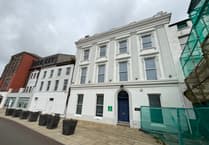As today is a national day in Norway, we took the opportunity to explore some of the Norse heritage in the island.
Whilst there is not much evidence of the Norwegian language impacting the Manx language, many place names in the island come from Norway.
For example, Snae Fell, translates into snow mountain; Laxey, means salmon river; Ramsey, means wild garlic river, and Langness translates into long headland.
Dr Sue Nicol, a retired academic, who wrote a module New Scandinavia for Chester University, and taught the module at UCM to third year history students explained.
She said: ‘I am fascinated by the fact that most of the Manx place names that have got a Norwegian element are places that you can see from the sea.
‘The words like Snae Fell and Langness, are presumably survivors of seafarers coming back to the island and navigating their way to the right harbours by these places, which I think is a fascinating comment about the Vikings relationship to the island.
‘I am also aware that because they were settlers by enlarge, they were marrying local women a lot, and it was the women that were bringing up their children a lot which meant it was the Manx language which tended to predominate.
‘So while we do have elements of Norwegian in place names, essentially it didn’t change the language too much from what has been found.’
She added: ‘It was somewhere around the end of the 19th century, there were a number of knowledgeable historians who said we have a rich past here lets have a museum and start an archive.
‘I think it was at that point that looking both at the Scandinavian past and the Celtic past became much more in people’s consciousness.
‘Yet I think that the culture of Scandinavia is woven into Manx society so much that you can’t see the joints.
‘For example, those early Viking settlers would have been bringing some of their farming techniques from Norway and adapting them to Manx farming techniques in a way that is just so seamless, so now you wouldn’t notice where the Scandinavian aspects were, because they are just so part of being Manx.’
The fusion of Celtic and Scandinavian heritage can be seen on the Manx crosses that are scattered across the island.
Dr Nicol said: ‘There are crosses where there are both Norse gods and goddesses, and Christian elements as well as having different forms of language on the same cross.
‘I feel that the connection with Norway is strong because it is part of that narrative of not being part of Britain.’
Randi Anne Lunde, a Norwegian in the island, said: ‘On Tynwald Day, they have the Norse village, and I think that is a way for people on the Isle of Man to celebrate their Norse heritage, aside from the brutality of the Vikings, but you don’t really get those kinds of things in Norway.’
In July this year, 34 Norwegians will be coming to the island in a bid to foster a closer relationship to the island.





Comments
This article has no comments yet. Be the first to leave a comment.